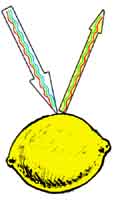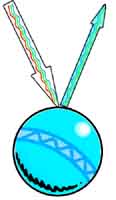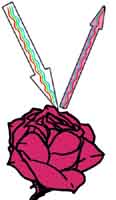Color and Color Television
 Before we begin learning about how a television creates color, we need to talk
about how colors interact. The way that theatre lights are applied is a good
example.
Before we begin learning about how a television creates color, we need to talk
about how colors interact. The way that theatre lights are applied is a good
example.

 I don't quite understand. In that picture, it looks like green and red make
yellow. In art class, they always teach you about the primary colors. Yellow
and blue make green, and green and red make a nasty kind of brown. This
doesn't follow those rules?
I don't quite understand. In that picture, it looks like green and red make
yellow. In art class, they always teach you about the primary colors. Yellow
and blue make green, and green and red make a nasty kind of brown. This
doesn't follow those rules?
 There are actually two sets of rules for mixing colors. The first one has to
do with mixing light, and the second one has more to do with mixing things
like paint. Why don't we do an experiment with light mixing?
There are actually two sets of rules for mixing colors. The first one has to
do with mixing light, and the second one has more to do with mixing things
like paint. Why don't we do an experiment with light mixing?
Click and Drag on the color squares to rearrange the pattern.
 That explains why a stage looks black when there are no lights shining on it!
I see how it works, but it still seems strange that I could get yellow light
from red and green.
That explains why a stage looks black when there are no lights shining on it!
I see how it works, but it still seems strange that I could get yellow light
from red and green.
|
 Well, this kind of mixing adds the two colors, and our brain sees the result
as a new color, even though the new color isn't actually there.
Well, this kind of mixing adds the two colors, and our brain sees the result
as a new color, even though the new color isn't actually there.
|
 That still doesn't explain the other set of rules for art class.
That still doesn't explain the other set of rules for art class.
 The key difference is that a picture by itself is not a source of light. The red,
green, and blue components of the white light illuminating the picture are either reflected
or absorbed. The reflected components are then added together in the same way as the
stage lights. A yellow surface absorbs blue light, and reflects red and green.
The key difference is that a picture by itself is not a source of light. The red,
green, and blue components of the white light illuminating the picture are either reflected
or absorbed. The reflected components are then added together in the same way as the
stage lights. A yellow surface absorbs blue light, and reflects red and green.
 |
 |
 |
 I think I am beginning to understand! When I mix yellow and cyan, the yellow
absorbs the blue component of light while the cyan absorbs the red part of
light, and green is the only thing remaining for me to see.
I think I am beginning to understand! When I mix yellow and cyan, the yellow
absorbs the blue component of light while the cyan absorbs the red part of
light, and green is the only thing remaining for me to see.
 You've got it! Now we can begin to talk about how your color TV works.
You've got it! Now we can begin to talk about how your color TV works.






